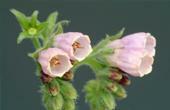Comfrey( Sympbytum officinale)

A powerful beautiful comfrey plant is found in humid places along the banks of rivers and streams in the Crimea, Siberia, the Carpathians, in the middle and southern strip of Russia. Fine honey plant.
Description
Comfrey is a perennial high herbaceous plant with a powerful root system, branched rough stems reaching 1 m in height, lanceolate, stiff-haired leaves tapering into the petiole, grow from a thick juicy rhizome, black outside and white inside. Red-violet, sometimes yellowish-white flowers are collected in a drooping racemose inflorescence( curl).Blooms from May to July.
Composition of
Comfrey roots contain mucous and tannic substances, resins, alkaloids of laziocarpine and cynoglossin, allantoin. In the grass comfrey also contains alkaloids.
Growing
Preferably moisturized sunny and semi-dark areas. Every year in the spring period requires fertilizer compost. Reproduction is carried out by division and root layers, planting is carried out in the spring. Comfrey likes spacious plots, one plant requires an area of an average size of 1 m2.The comfrey is a decorative plant and can serve as an ornament of a herb garden.
Collection
Fresh leaves for external use are collected as needed. Collection of roots for drying is carried out in autumn and spring after the end of the growing season or before its beginning, respectively. Roots are washed, cut into strips, stringed on a string and hung in a ventilated place. You can dry the chopped roots of the comfrey, simply spreading them a thin layer on the fabric. Do not forget to regularly harness raw materials: comfrey roots tend to mold.
Medicinal properties of
Leaves are used for short external use in stretching, bruising and bruising. Comfrey's roots have antitumor, emollient, expectorant effect. Other comfrey types, such as comfrey ( Symphytum asperum), comfrey ( S. caucasicum), also have valuable medicinal properties. The action of the alkaloids contained in their roots is actively studied.
Application of
Roots are used more often in fresh and mashed or dried form for compresses in fractures and wounds, rheumatic articular pains and inflammation of the periosteum. Decoction from the root of the comfrey is taken orally as a remedy for coughing and with gastrointestinal disorders.
